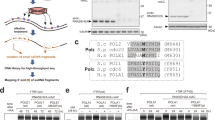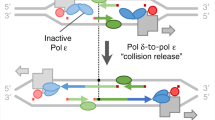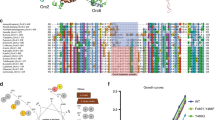Abstract
Three eukaryotic DNA polymerases are essential for genome replication. Polymerase (Pol) α–primase initiates each synthesis event and is rapidly replaced by processive DNA polymerases: Polɛ replicates the leading strand, whereas Polδ performs lagging-strand synthesis. However, it is not known whether this division of labor is maintained across the whole genome or how uniform it is within single replicons. Using Schizosaccharomyces pombe, we have developed a polymerase usage sequencing (Pu-seq) strategy to map polymerase usage genome wide. Pu-seq provides direct replication-origin location and efficiency data and indirect estimates of replication timing. We confirm that the division of labor is broadly maintained across an entire genome. However, our data suggest a subtle variability in the usage of the two polymerases within individual replicons. We propose that this results from occasional leading-strand initiation by Polδ followed by exchange for Polɛ.
This is a preview of subscription content, access via your institution
Access options
Subscribe to this journal
Receive 12 print issues and online access
$189.00 per year
only $15.75 per issue
Buy this article
- Purchase on Springer Link
- Instant access to full article PDF
Prices may be subject to local taxes which are calculated during checkout






Similar content being viewed by others
Accession codes
References
Bartkova, J. et al. DNA damage response as a candidate anti-cancer barrier in early human tumorigenesis. Nature 434, 864–870 (2005).
Gorgoulis, V.G. et al. Activation of the DNA damage checkpoint and genomic instability in human precancerous lesions. Nature 434, 907–913 (2005).
Rhind, N. & Gilbert, D.M. DNA replication timing. Cold Spring Harb. Perspect. Biol. 5, a010132 (2013).
Stillman, B. Origin recognition and the chromosome cycle. FEBS Lett. 579, 877–884 (2005).
Hawkins, M. et al. High-resolution replication profiles define the stochastic nature of genome replication initiation and termination. Cell Reports 5, 1132–1141 (2013).
Ryba, T. et al. Evolutionarily conserved replication timing profiles predict long-range chromatin interactions and distinguish closely related cell types. Genome Res. 20, 761–770 (2010).
O'Donnell, M., Langston, L. & Stillman, B. Principles and concepts of DNA replication in bacteria, archaea, and eukarya. Cold Spring Harb. Perspect. Biol. 5, a010108 (2013).
Moyer, S.E., Lewis, P.W. & Botchan, M.R. Isolation of the Cdc45/Mcm2–7/GINS (CMG) complex, a candidate for the eukaryotic DNA replication fork helicase. Proc. Natl. Acad. Sci. USA 103, 10236–10241 (2006).
Gambus, A. et al. A key role for Ctf4 in coupling the MCM2–7 helicase to DNA polymerase alpha within the eukaryotic replisome. EMBO J. 28, 2992–3004 (2009).
Simon, A.C. et al. A Ctf4 trimer couples the CMG helicase to DNA polymerase α in the eukaryotic replisome. Nature 510, 293–297 (2014).
Sengupta, S., van Deursen, F., de Piccoli, G. & Labib, K. Dpb2 integrates the leading-strand DNA polymerase into the eukaryotic replisome. Curr. Biol. 23, 543–552 (2013).
Handa, T., Kanke, M., Takahashi, T.S., Nakagawa, T. & Masukata, H. DNA polymerization-independent functions of DNA polymerase epsilon in assembly and progression of the replisome in fission yeast. Mol. Biol. Cell 23, 3240–3253 (2012).
Muramatsu, S., Hirai, K., Tak, Y.S., Kamimura, Y. & Araki, H. CDK-dependent complex formation between replication proteins Dpb11, Sld2, Pol ɛ, and GINS in budding yeast. Genes Dev. 24, 602–612 (2010).
Pursell, Z.F., Isoz, I., Lundstrom, E.B., Johansson, E. & Kunkel, T.A. Yeast DNA polymerase epsilon participates in leading-strand DNA replication. Science 317, 127–130 (2007).
Nick McElhinny, S.A., Gordenin, D.A., Stith, C.M., Burgers, P.M. & Kunkel, T.A. Division of labor at the eukaryotic replication fork. Mol. Cell 30, 137–144 (2008).
Miyabe, I., Kunkel, T.A. & Carr, A.M. The major roles of DNA polymerases epsilon and delta at the eukaryotic replication fork are evolutionarily conserved. PLoS Genet. 7, e1002407 (2011).
Nick McElhinny, S.A. et al. Abundant ribonucleotide incorporation into DNA by yeast replicative polymerases. Proc. Natl. Acad. Sci. USA 107, 4949–4954 (2010).
Sparks, J.L. et al. RNase H2-initiated ribonucleotide excision repair. Mol. Cell 47, 980–986 (2012).
Kim, N. et al. Mutagenic processing of ribonucleotides in DNA by yeast topoisomerase I. Science 332, 1561–1564 (2011).
Williams, J.S. et al. Topoisomerase 1-mediated removal of ribonucleotides from nascent leading-strand DNA. Mol. Cell 49, 1010–1015 (2013).
Sekiguchi, J. & Shuman, S. Site-specific ribonuclease activity of eukaryotic DNA topoisomerase I. Mol. Cell 1, 89–97 (1997).
Watt, D.L., Johansson, E., Burgers, P.M. & Kunkel, T.A. Replication of ribonucleotide-containing DNA templates by yeast replicative polymerases. DNA Repair (Amst.) 10, 897–902 (2011).
Williams, J.S. & Kunkel, T.A. Ribonucleotides in DNA: origins, repair and consequences. DNA Repair (Amst.) 19, 27–37 (2014).
Lujan, S.A., Williams, J.S., Clausen, A.R., Clark, A.B. & Kunkel, T.A. Ribonucleotides are signals for mismatch repair of leading-strand replication errors. Mol. Cell 50, 437–443 (2013).
Xu, J. et al. Genome-wide identification and characterization of replication origins by deep sequencing. Genome Biol. 13, R27 (2012).
Shiozaki, K., Shiozaki, M. & Russell, P. Heat stress activates fission yeast Spc1/StyI MAPK by a MEKK-independent mechanism. Mol. Biol. Cell 9, 1339–1349 (1998).
Müller, C.A. et al. The dynamics of genome replication using deep sequencing. Nucleic Acids Res. 42, e3 (2014).
Retkute, R., Nieduszynski, C.A. & de Moura, A. Mathematical modeling of genome replication. Phys. Rev. E 86, 031916 (2012).
Clausen, A.R. et al. Tracking replication enzymology in vivo by genome-wide mapping of ribonucleotide incorporation. Nat. Struct. Mol. Biol. doi:10.1038/nsmb.2957 (26 January 2015).
Koh, K.D., Balachander, S., Hesselberth, J.R. & Storici, F. Ribose-seq: global mapping of ribonucleotides embedded in genomic DNA. Nat. Methods doi:10.1038/nmeth.3259 (26 January 2015).
Reijns, M.A.M. et al. Lagging strand replication shapes the mutational landscape of the genome. Nature doi:10.1038/nature14183 (26 January 2015).
Siow, C.C., Nieduszynska, S.R., Muller, C.A. & Nieduszynski, C.A. OriDB, the DNA replication origin database updated and extended. Nucleic Acids Res. 40, D682–D686 (2012).
Fachinetti, D. et al. Replication termination at eukaryotic chromosomes is mediated by Top2 and occurs at genomic loci containing pausing elements. Mol. Cell 39, 595–605 (2010).
Lang, G.I. & Murray, A.W. Mutation rates across budding yeast chromosome VI are correlated with replication timing. Genome Biol. Evol. 3, 799–811 (2011).
Ulrich, H.D. & Takahashi, T. Readers of PCNA modifications. Chromosoma 122, 259–274 (2013).
Dua, R., Levy, D.L. & Campbell, J.L. Analysis of the essential functions of the C-terminal protein/protein interaction domain of Saccharomyces cerevisiae pol epsilon and its unexpected ability to support growth in the absence of the DNA polymerase domain. J. Biol. Chem. 274, 22283–22288 (1999).
Feng, W. & D'Urso, G. Schizosaccharomyces pombe cells lacking the amino-terminal catalytic domains of DNA polymerase epsilon are viable but require the DNA damage checkpoint control. Mol. Cell. Biol. 21, 4495–4504 (2001).
Georgescu, R.E. et al. Mechanism of asymmetric polymerase assembly at the eukaryotic replication fork. Nat. Struct. Mol. Biol. 21, 664–670 (2014).
Moreno, S., Klar, A. & Nurse, P. Molecular genetic analysis of fission yeast Schizosaccharomyces pombe. Methods Enzymol. 194, 795–823 (1991).
Watson, A.T., Garcia, V., Bone, N., Carr, A.M. & Armstrong, J. Gene tagging and gene replacement using recombinase-mediated cassette exchange in Schizosaccharomyces pombe. Gene 407, 63–74 (2008).
Lipkin, D., Talbert, P.T. & Cohn, M. The mechanism of the alkaline hydrolysis of ribonucleic acids. J. Am. Chem. Soc. 76, 2871–2872 (1954).
Zhang, Z., Theurkauf, W.E., Weng, Z. & Zamore, P.D. Strand-specific libraries for high throughput RNA sequencing (RNA-Seq) prepared without poly(A) selection. Silence 3, 9 (2012).
Acknowledgements
We thank J. Murray and S. Mohebi for assistance with elutriation and T. Kunkel for advice on polymerase mutation. A.M.C. acknowledges UK Medical Research Council grant G1100074 and European Research Council grant 268788-SMI-DDR. C.A.N. acknowledges Biotechnology and Biological Sciences Research Council grant BB/K007211/1. Y.D. acknowledges a postdoctoral fellowship for research abroad from the Japan Society for the Promotion of Science.
Author information
Authors and Affiliations
Contributions
A.M.C. conceived the study. A.M.C., I.M., Y.D., C.A.M., A.K., M.H. and C.A.N. designed the experimental and computational approaches. Y.D., I.M., C.A.N., C.A.M., A.K., T.B. and R.R. performed experiments and analysis. A.M.C. wrote the manuscript. C.A.N., Y.D. and A.K. edited the manuscript.
Corresponding authors
Ethics declarations
Competing interests
The authors declare no competing financial interests.
Integrated supplementary information
Supplementary Figure 1 Distribution of replication-origin and termination efficiencies.
(a) The distribution of origin efficiencies (Efori). (b) The distribution of termination frequencies in each 1 kb bin. (c) Left: the observed Polδ bias is maintained in a rad18Δ (rhp18Δ) mutant in which PCNA cannot be modified. Right: replication timing of the three chromosomes (see Fig. 5a). The regions considered “early” replicating are shown in pink and correspond to the pink regions in the vertical bar on the heat map.
Supplementary Figure 2 A genome-wide plot of the polymerase usage.
The top two panels show Polɛ (cdc20-M630F; red), and Polδ (cdc6-L519G; blue) usage on the Watson and Crick strands. The third panel shows the BrdU sequence mapping of origins and red bars indicating the position and efficiency (height) of origins identified from the polymerase usage data. The bottom panel shows median replication timing (Trep) derived from the synchronous culture marker frequency analysis (Fig. 4a).
Supplementary Figure 3 Sequence composition of ribonucleotide incorporation.
Analysis of the sequence composition of ribonucleotide incorporation and the +3 and -3 flanking nucleotides for the wild type polymerase, cdc6-L591G (Polδ) and cdc20-M630F (Polɛ) mutants in the rnh201Δ background.
Supplementary Figure 4 Analysis of nucleotide incorporation into gene coding regions.
(a) Ribonucleotide incorporation into the open reading frame (CDS), the 5’ and 3’ untranslated regions (UTR) and 500bp upstream of the transcription start site (promoter) according to the annotations from the Broad Institute. Data divided by gene size (b) (longer or shorter than 3000 bp, long and short, respectively) and transcript level (c) All transcriptional units are categorised into high or low level of transcription groups derived from table S4 of Marguerat, S. et al. Cell 151, 671–683, 2012, with a threshold of 125. The wide spread of the data corresponding to the high transcript level group is due to the relatively low number (149) of highly transcribed units.
Supplementary information
Supplementary Text and Figures
Supplementary Figures 1–4 and Supplementary Tables 2 and 3 (PDF 2373 kb)
Supplementary Table 1
Origin efficiencies and location (XLS 186 kb)
Supplementary Data Set 1
Southern blots used in Fig. 1b (PDF 63 kb)
Rights and permissions
About this article
Cite this article
Daigaku, Y., Keszthelyi, A., Müller, C. et al. A global profile of replicative polymerase usage. Nat Struct Mol Biol 22, 192–198 (2015). https://doi.org/10.1038/nsmb.2962
Received:
Accepted:
Published:
Issue Date:
DOI: https://doi.org/10.1038/nsmb.2962
This article is cited by
-
Global landscape of replicative DNA polymerase usage in the human genome
Nature Communications (2022)
-
Mapping ribonucleotides embedded in genomic DNA to single-nucleotide resolution using Ribose-Map
Nature Protocols (2021)
-
How asymmetric DNA replication achieves symmetrical fidelity
Nature Structural & Molecular Biology (2021)
-
Replication dynamics of recombination-dependent replication forks
Nature Communications (2021)
-
DNA copy-number measurement of genome replication dynamics by high-throughput sequencing: the sort-seq, sync-seq and MFA-seq family
Nature Protocols (2020)



